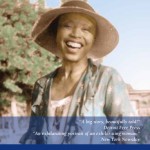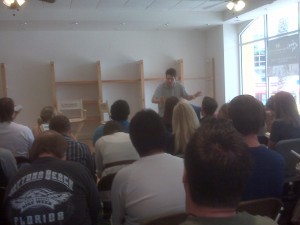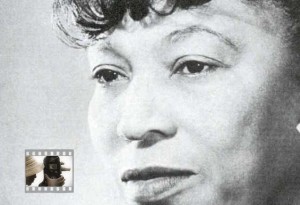May
27
2010
Jump at the Sun had a private screening at Santa Monica College on May 18 for David Burak’s English class, and was sponsored by the SMC English Dept, Black Collegians Club, SMC Associates, SMC Communication Dept, and Asian-American Pacific Islander Achievement. I was blown away by the students, almost 30,000 total at this fascinating school. A cross-cultural collection in attendance, they embraced Zora’s independence, her Black Nationalism, her love of self and culture. What a beautiful campus in a breathtaking city, perched on the edge of the Pacific Ocean. Zora Neale Hurston had visited California in 1940, driving all the way from Florida, and she wrote about her time there, working briefly for Paramount Pictures. She visited her friend, dancer Katherine Mershon, up in the mountains. For someone whose idea of way up high is the Chinaberry tree in her hometown of Eatonville, she was blown away by the constant climbing.
on May 18 for David Burak’s English class, and was sponsored by the SMC English Dept, Black Collegians Club, SMC Associates, SMC Communication Dept, and Asian-American Pacific Islander Achievement. I was blown away by the students, almost 30,000 total at this fascinating school. A cross-cultural collection in attendance, they embraced Zora’s independence, her Black Nationalism, her love of self and culture. What a beautiful campus in a breathtaking city, perched on the edge of the Pacific Ocean. Zora Neale Hurston had visited California in 1940, driving all the way from Florida, and she wrote about her time there, working briefly for Paramount Pictures. She visited her friend, dancer Katherine Mershon, up in the mountains. For someone whose idea of way up high is the Chinaberry tree in her hometown of Eatonville, she was blown away by the constant climbing.

English teacher David Burak has been described as an “activist” and a former “protestor” and I liked his engaging and questioning spirit immensely. He should be crowned Mayor of the College, or at least given an honorary parking pass if they haven’t already. It was very nice of David to throw in a little smog when I took his photo.
And while Jump at the Sun was busy visiting the Left Coast, the Deedle Deedle Dees paid Zora homage in an interesting little ditty at the Knitting Factory in Williamsburg, a burg of Brooklyn NY.
no comments | posted in About Filmmaking, Events, Jump At The Sun Screenings, Zora Neale Hurston
May
12
2010
Sound the alarms! PBS veteran producer Joel Geyer is video blogging from Budapest where PBS stations from around the world are having their annual meeting. Yes, there are Public Broadcasting stations in almost every country, and from what Joel has to say, there are still plenty of staid historical documentaries in the loop. Joel seems to be more tolerant of these than most of us.
Via video, Joel has passed along a few choice tidbits including:
– Viral networking is over-rated, Twitter is useless, Facebook has an older demographic;
– Canon MarkII 5D camera is taking over the industry (and for only $2300 at B&H);
– Programs made by filming bloggers are a new hot product (built-in audience);
– Real people telling real stories is still a cheap new way to produce programming:
– TV as we know it is dead!!! Okay, I know. They keep saying it but this time it really is dead. Surfing for content on computers is the new TV.
no comments | posted in About Filmmaking, Events
Apr
26
2010
Please note this “event” has passed.
Gotta have your Zora? Get her on the Online. 
Here are some links to catch the award-winning PBS’ American Masters film, produced and written by Kristy Andersen (yours truly):
California Newsreel, the film’s educational distributor, is offering a sneak preview for those schools who have dallied and still have some money in the coffers at the end of the school year to buy a copy. Just follow the link.
Other fans have linked and are offering a chance to view on their pages:
ThisBlkSistasPage
MaxReddick/topsy
Msinklination
no comments | posted in About Filmmaking, Jump At The Sun Screenings, Zora Neale Hurston
Apr
16
2010
 I attended the Sunscreen Film Festival workshop on Indie Film Producing and another on Master Screenwriting yesterday at St. Petersburg’s troubled BayWalk, where the storefronts are empty. The availability of space is a fortunate coincidence for the workshops which are part of the festival.
I attended the Sunscreen Film Festival workshop on Indie Film Producing and another on Master Screenwriting yesterday at St. Petersburg’s troubled BayWalk, where the storefronts are empty. The availability of space is a fortunate coincidence for the workshops which are part of the festival.
As a festival, Sunscreen doesn’t shine so much from its selection of first-run nationally coveted festival films, though there are a few. Rather it has excelled at keeping locals in the mix.
But it’s the workshops – geared exclusively for fiction narrative – that I found to be first-rate.
Classes are small, maybe 70 attendees, and the teaching moves at a quick clip, full of relevant and important information. Having attended some similar workshops in major cities, I much preferred this more intimate setting – it was so intimate that Dean Batali, the workshop leader and Head Writer for That 70’s Show and Buffy the Vampire Slayer, apologized for slewing spittle on the front row. I think he was kidding.
But this was not regurgitated information. Class leaders are current and all knowing. Indie producers Sean Covel and Doc Wyatt honed their skills on various films but their blockbuster was Napolean Dynamite, a classic example of a low-budget film ($500,000) that took naysayers by surprise.
At $35 for a day pass, you get the classes and the films, a very reasonable rate for the talent at hand. And although there aren’t classes for nonfiction film, good writing and good production advice applies across genres.
Grab some spf15 and head on down to Baywalk – just steer clear of that front row.
no comments | posted in About Filmmaking, Events
Mar
31
2010
Zora Neale Hurston’s name is almost synonymous with the Harlem Renaissance. Yet, she spent only a modest amount of her time in Harlem during the decade it flourished as an incubator for black arts in America, from 1920 until the stock market crashed in 1929, launching the Great Depression.
 Zora arrived in New York in 1925 and in 1927 she was given a 16-mm camera and a car by her patron Charlotte Osgood Mason, and immediately headed south to Florida. A majority of the footage from 1927 consists of children playing games. Researcher Keith Bollum has identified the location as Loughman, Florida, the site of an immense central Florida lumber yard and sawmill, the same place where Zora gathered stories for her anthropological collection Mules and Men. Other footage appears to be Bartow where she documented a medical “root doctor” whom she also wrote about in Mules and Men. She side-tracked to Mobile Alabama, interviewing and filming Cudjo Lewis, the last living African to have made the Journey of the Middle Passage to America as a slave (on an illegal slave ship, as slave transport had been banned). Unfortunately, the audio didn’t survive, and neither did footage of “the Zulu Crew” from New Orleans, nor dancers on a beach (a list Mason created describing Zora’s footage is in an archive at Howard University). Because Zora’s interest was black folk culture, she shot footage at baseball bleechers in Florida, most likely one used by the Negro Leagues, and yet she filmed the average folks in the stands but not the players.
Zora arrived in New York in 1925 and in 1927 she was given a 16-mm camera and a car by her patron Charlotte Osgood Mason, and immediately headed south to Florida. A majority of the footage from 1927 consists of children playing games. Researcher Keith Bollum has identified the location as Loughman, Florida, the site of an immense central Florida lumber yard and sawmill, the same place where Zora gathered stories for her anthropological collection Mules and Men. Other footage appears to be Bartow where she documented a medical “root doctor” whom she also wrote about in Mules and Men. She side-tracked to Mobile Alabama, interviewing and filming Cudjo Lewis, the last living African to have made the Journey of the Middle Passage to America as a slave (on an illegal slave ship, as slave transport had been banned). Unfortunately, the audio didn’t survive, and neither did footage of “the Zulu Crew” from New Orleans, nor dancers on a beach (a list Mason created describing Zora’s footage is in an archive at Howard University). Because Zora’s interest was black folk culture, she shot footage at baseball bleechers in Florida, most likely one used by the Negro Leagues, and yet she filmed the average folks in the stands but not the players.
This early footage documented precisely the culture and people Zora wrote about in her books and was an important asset for my film, Jump at the Sun.
no comments | posted in About Filmmaking, Zora Neale Hurston
 on May 18 for David Burak’s English class, and was sponsored by the SMC English Dept, Black Collegians Club, SMC Associates, SMC Communication Dept, and Asian-American Pacific Islander Achievement. I was blown away by the students, almost 30,000 total at this fascinating school. A cross-cultural collection in attendance, they embraced Zora’s independence, her Black Nationalism, her love of self and culture. What a beautiful campus in a breathtaking city, perched on the edge of the Pacific Ocean. Zora Neale Hurston had visited California in 1940, driving all the way from Florida, and she wrote about her time there, working briefly for Paramount Pictures. She visited her friend, dancer Katherine Mershon, up in the mountains. For someone whose idea of way up high is the Chinaberry tree in her hometown of Eatonville, she was blown away by the constant climbing.
on May 18 for David Burak’s English class, and was sponsored by the SMC English Dept, Black Collegians Club, SMC Associates, SMC Communication Dept, and Asian-American Pacific Islander Achievement. I was blown away by the students, almost 30,000 total at this fascinating school. A cross-cultural collection in attendance, they embraced Zora’s independence, her Black Nationalism, her love of self and culture. What a beautiful campus in a breathtaking city, perched on the edge of the Pacific Ocean. Zora Neale Hurston had visited California in 1940, driving all the way from Florida, and she wrote about her time there, working briefly for Paramount Pictures. She visited her friend, dancer Katherine Mershon, up in the mountains. For someone whose idea of way up high is the Chinaberry tree in her hometown of Eatonville, she was blown away by the constant climbing.


